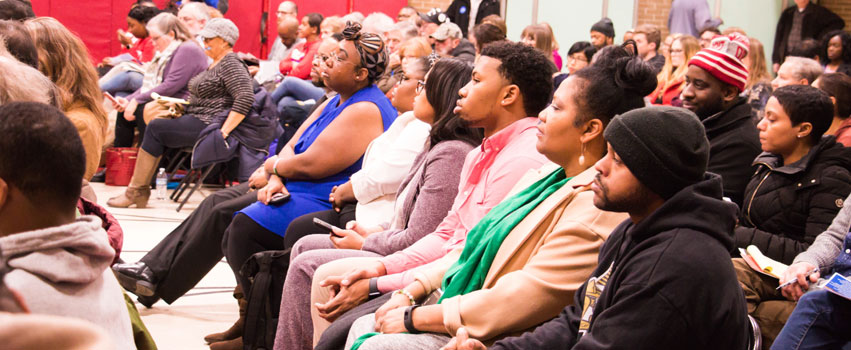Of Shapes, Lines and Movement
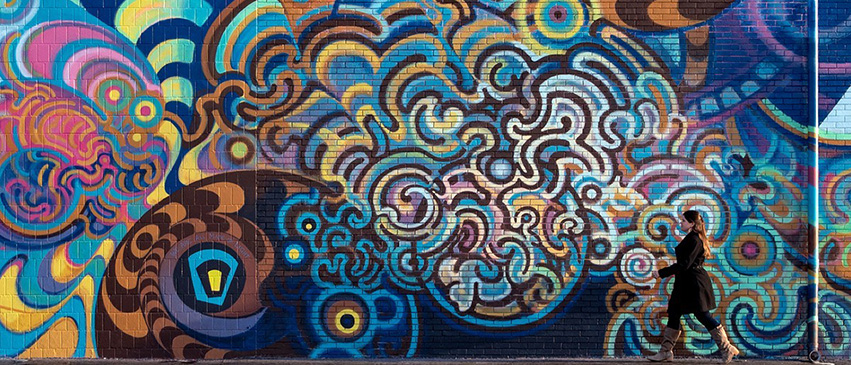
If you have spent any time in Peoria’s Warehouse District or the Riverfront recently, you likely have noticed an array of colorful public art—the pieces as striking as they are dizzying in their presence. From “We Are All Made of Light,” the mural painted outside of UFS Downtown Outlet Warehouse, to the “Easterseals Rainbow” at the Peoria Riverfront Museum and “Trouble the Water,” a towering 30-foot installation located at 1212 SW Adams, they are intriguing and delightful additions to the urban-industrial landscape.
The person behind these works is Heather Brammeier: Bradley University professor, sculptor, painter and installation artist. She has received a myriad of awards and artist residencies both nationally and internationally, and has been exhibited everywhere from New York City to South Korea and the United Kingdom. In her work, Brammeier seeks to explore the function of childhood play into adulthood, using materials in innovative ways to create visual puzzles that invite movement in and around her work. Not surprisingly, her story begins at a young age. And like her work, it takes several unexpected twists and turns, but somehow fits together perfectly in the end.
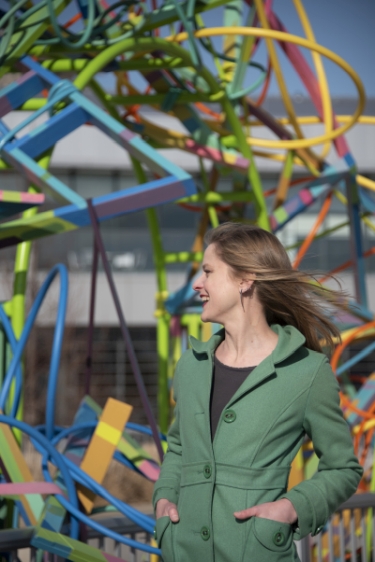
DIY Roots
“Not to sound like a cliché, but I really am an artist because of my mom,” Brammeier begins. “If she wanted to do something, she would learn how to do it—and do it really well.” Her mother was a perfectionist, but that was not a quality she encouraged in her daughter; quite the opposite, in fact. She wanted Brammeier to experiment and find creative solutions to problems.
“My mom made us dresses all the time. She could have shown me how to do it, but she knew that I rebelled against having a pattern,” she explains with a chuckle. “She allowed me to do things the way I wanted to. And they would come out wonky and funky and weird, and I’d wear strange things to school.”
Growing up just outside of Chicago, Brammeier says that she idolized the lives and lifestyles of artists, especially those who worked with paint. “I thought painters were the coolest people in the world,” she recalls. “But I definitely thought I wasn’t good enough to be an artist.”
It was only when she began attending Bradley University that Brammeier started to focus on her artistic talents. The university did not require students to have a portfolio in order to begin their coursework, a policy they still hold to this day. “And that is actually a really good thing,” she points out, “because I was able to have the experience of being in a college studio art class.”
Looking around the studio, Brammeier was able to compare her drawings to those of other students. “I thought, ‘Oh, I am actually kind of good at this!’ I just enjoyed it so much.” Still, she agonized over the practicality of pursuing the arts as a career—at one point considering a double major in art and physics. “Just so I would have something to fall back on,” she laughs. Ultimately, she chose to pursue a major in art education. And the more she delved into the arts, the more her confidence grew.
In the years following her graduation from Bradley, Brammeier completed the prestigious MFA program at the University of Pennsylvania and spent a year teaching art at a middle school. It was during that time that Bradley Professor of Art Oscar Gillespie reached out about a teaching position that had recently opened up. “Again, there was this ‘click’ in my head,” she recalls. “Maybe I am good enough to do it.”
This process of progressive realizations is directly linked to Brammeier’s artistic process. “I’m always trying to do something that seems like it’s probably beyond my reach,” she explains. “I’ve always been very ambitious as an artist. I think I just had to convince myself to be ambitious as a person in terms of my career as well.”
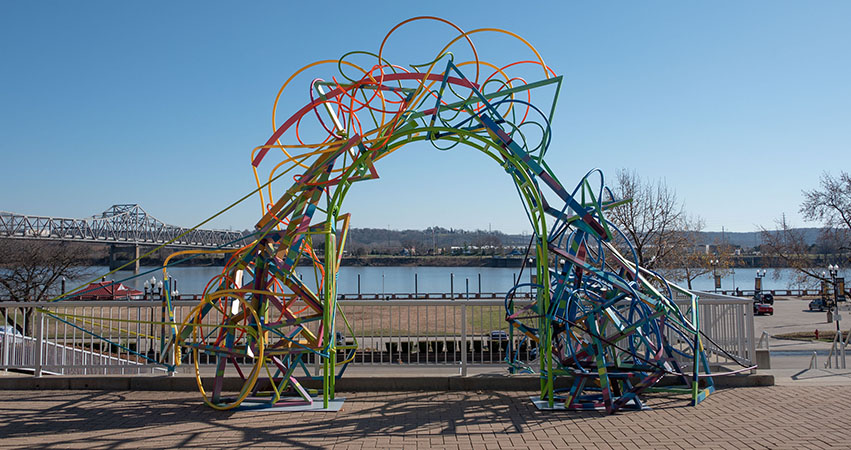
Pursuing a Vision
In contemplating her varied work as a sculptor, painter, installation artist and professor, it is difficult to know where to begin our discussion. “It’s tricky,” Brammeier agrees with a smile. In recent years she has shifted her focus somewhat, away from painting toward more sculpture and installation. In doing so, she has followed two intertwining paths. Her installations, which tend to be indoors in museums and galleries, make use of natural materials and colors, and are often filled with personal and emotional content. And then there are her outdoor sculptural works, which are generally more vibrant and fun.
One of her most recent sculptures falls solidly into this second category. Commissioned by Easterseals Central Illinois, Brammeier’s “Easterseals Rainbow” stands tall outside the Peoria Riverfront Museum—a physical depiction of security, community and happiness.
Rather than beams of light, this rainbow is comprised of everything from colorfully painted PEX tubing and garden hoses to pieces of lumber. The sprawling structure is an impressive 25 feet tall, and aside from the aluminum arch at its center, Brammeier constructed the entire piece on her own, without assistance. Leaning on the DIY skills she learned at the encouragement of her mother and honed by years of experience, she began to build around the arch, improvising as she went along.
The materials appear woven together in seemingly impossible ways, held up by opposing forces. As she constructs her work, Brammeier is constantly trying to push the envelope, finding ways to rest heavy pieces against one another long enough for her to drill them in place. “While it looks precarious, if it fits together long enough for me to physically fasten it, that means there is some sort of hidden, built-in security to it,” she muses. There is no step-by-step procedure to her art; instead, she leaves plenty of room for discovery. “I am playing… like a little kid with wooden blocks—seeing how high I can stack them.”
In the hours, days or weeks spent on any one installation, Brammeier imagines and re-imagines her work, visualizing endless scenarios. She also puts in a great deal of strenuous labor. “I relish that,” she explains. “And that’s another reason I am doing a lot more sculpture and installation. It’s sort of something I need—but it needs to be purposeful.”
She also must consider the properties of the materials, as well as her own physical limitations. After all, constructing the “Easterseals Rainbow” out of steel could have easily cost hundreds of thousands of dollars, she notes. But where some might see limitations, Brammeier sees creative parameters. How tall can a sculpture get, given all of the factors she must consider? How long does she have for the installation, and how much can she get done within that time?
“It’s very stressful, but I love it,” she explains. “Because there are always these moments when you think, ‘Wow, what if none of this works?’”
Leaning on her past successes in problem-solving, these flashes of creative improvisation are truly magical for Brammeier. Whether finding ways to balance objects atop one another, or removing a support to create the illusion that her work is floating, she finds joy in testing physical and perceptual boundaries—while mirroring emotional and psychological limits. Although she inherited her mother’s perfectionism, she has walked along a path of acceptance, realizing that her work need not be perfect in order to be impactful. As she clarifies, “Finding solutions and shortcuts do not compromise your vision, but actually free you up to pursue your vision more.”
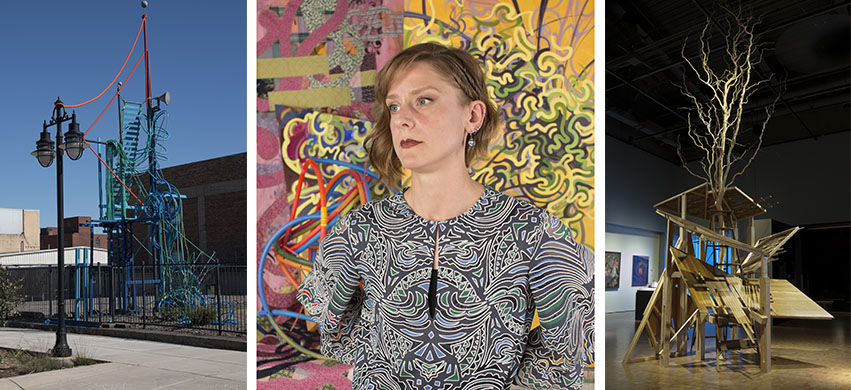
Layers of Meaning
While Brammeier very much inhabits the present—finding wonder in the seemingly endless possibilities of her work—she finds the past is equally important. Specifically: love and loss, and the role of memories in our lives.
Her first husband died suddenly from a brain aneurysm not long after their divorce. Later, after her mother’s death, Brammeier was clearing out her belongings when she found a file marked “Heather’s wedding.” Inside was a card from her deceased first husband to her mother, thanking her for entrusting her daughter to him. The discovery stunned Brammeier. “I got something from him beyond the grave,” she explains, “but only because my mother died as well.”
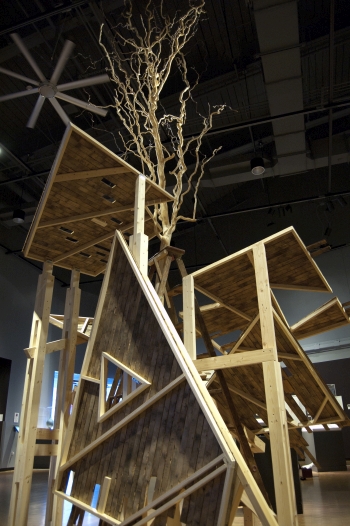
Some memories, she realized, are lost to us, forever unreachable. She will never know what her first husband was thinking when he wrote that note, nor how her mother responded. Yet her discovery provided new information about them that she did not have before—a treasured if incomplete bridge spanning the unforgiving chasm of time.
This realization gave rise to Brammeier’s “Fragments of the Unreachable,” a 2017 installation at the Peoria Riverfront Museum. Born of timing and introspection, the work centered around a stripped willow tree surrounded by large panels of flooring, all askew. The panels could not be walked upon—and while a ladder suggested both the tree and panel structure could be climbed, it remained tantalizingly inaccessible to the viewer.
Curly willow trees were one of her mother’s favorites, Brammeier explains. They are easily propagated—just pop a piece of one in a glass of water, and you’ll soon have a shoot ready to plant. Whenever she moved, her mother would give her new shoots to plant; but one had grown spindly in her backyard, displaying an unsightly bare spot. Her husband wanted to cut it down, but Brammeier convinced him to wait so she could use it in an installation.
Invited to create a piece at the museum, she wanted to make the most of the vast space available to her. “I knew if I stripped the bark off the tree, it would look so beautiful,” she recalls. While the installation reflected Brammeier’s internal struggle reconciling contradictory states of being, she adds that being denied access to the ladder does not necessarily end in frustration. For some, it evokes playfulness and fun as the viewer tries to determine how they might attempt the impossible.
All of these meanings resonate with her. “Even if something that I am making has some sad content behind it, that doesn’t mean I am sad the whole time I am making it,” she offers. “I enjoy making the work, and that comes through. I think that artwork can be fluid—and have a lot of layers of meaning.”
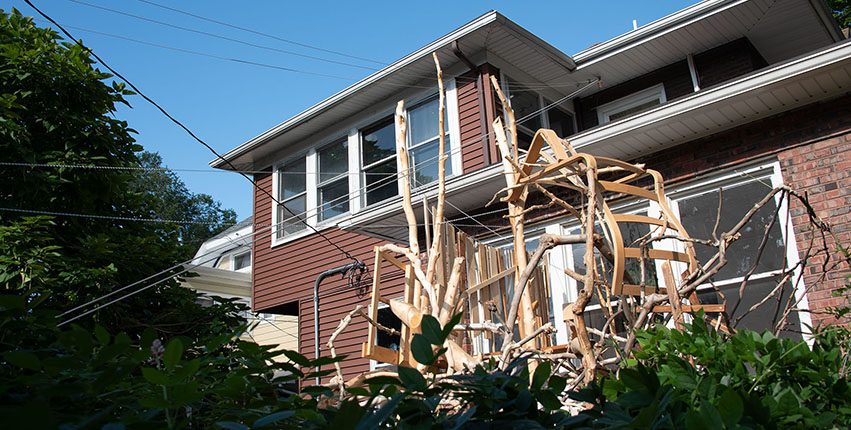
A World of Inspiration
As a working, exhibiting artist, Brammeier is able to serve as a role model for her students at Bradley University. One of the most rewarding aspects of her work is helping them accrue professional achievements while still in school. “I help them find exhibitions they can participate in, organize exhibitions of their work, and exhibit their artwork on campus,” she explains.
Brammeier is also involved with the I Found U global collective of interdisciplinary artists, which focuses on discourse and collaboration. Now mid-career, she mentors and encourages other artists in the collective, passing along practical advice. She then takes their stories back to her students, informing them of issues faced by artists around the world, and how these artists learn from each other.
“I tell them about an artist in Uruguay, who shared that her big concern right now is Venezuela’s economy, as it impacts Uruguay so heavily,” she offers. “Or an artist from Russia attending graduate school in the U.S., who has been impacted by the huge protests in her home country.” These stories take her students beyond the classroom experience, giving them real-world insights into the lives of working artists.
In recent years, Brammeier has focused more on giving back to her local community. She currently sits on the board of the Big Picture Initiative, works on committees with the Peoria Art Guild, and will soon join the Sky Art Peoria committee with ArtsPartners of Central Illinois.
Ultimately for Brammeier, her paintings, sculptures and installations have always been interrelated. “They’re always about these moving shapes and lines—but also how they balance on top of each other and fit together.” As she considers her own artistic future, she hopes to transition from temporary installations to more permanent pieces by working with a fabricator. “One of the things I am trying to figure out is how you can you do that without losing the spontaneity of just improvising and working on the fly. It’s tricky,” she admits.
And in true Heather Brammeier fashion, she adds cheerfully: “It’s a new problem that that I’m going to have to figure out!” PM
